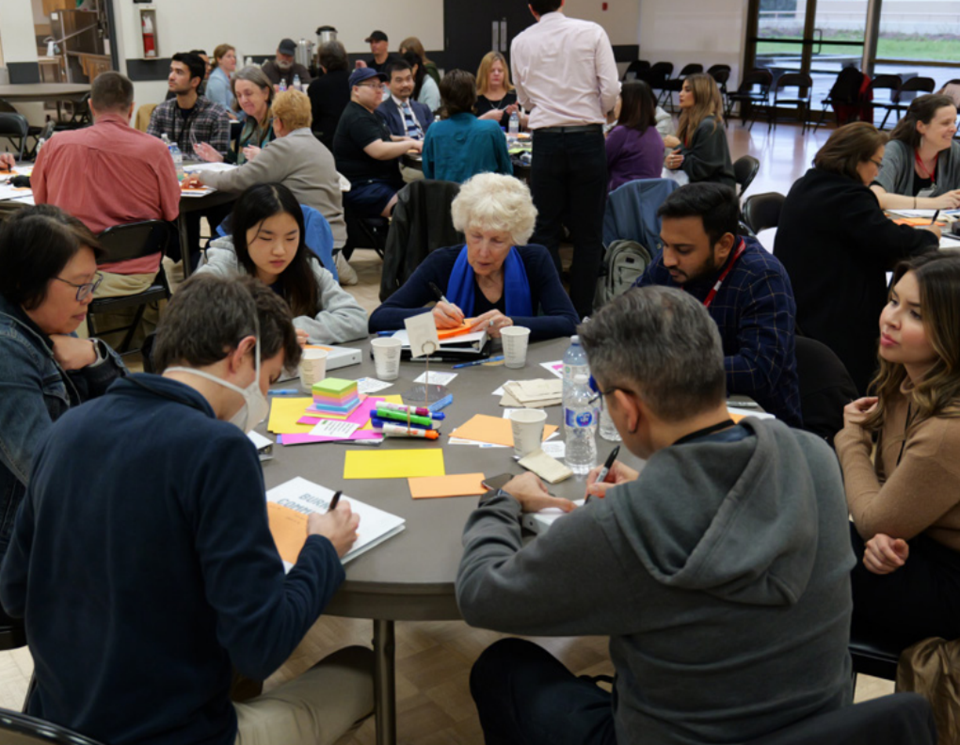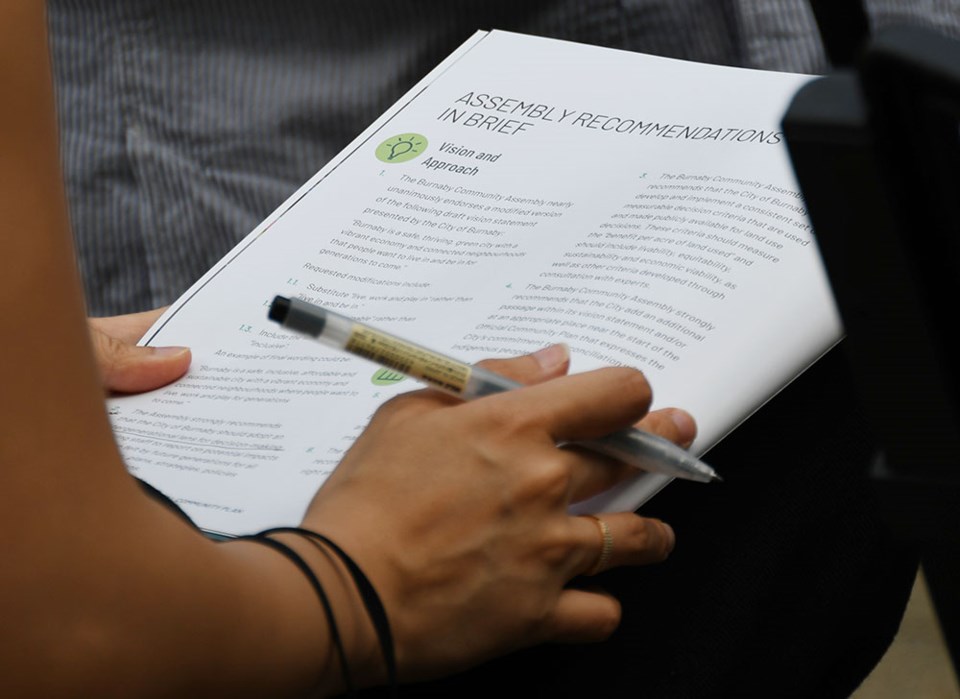Sitting around tables at Bonsor Community Centre in June, 40 Burnaby residents played the world première of the board game Burnabopoly.
A large poster board listed an array of public amenities: community centres, public libraries, parks, green spaces, affordable housing and more.
Then the playing cards were doled out.
Each represented a different piece of community infrastructure – a destination playground; a theatre; a rec complex with pools and an NHL-sized ice rink – and a price.
Players must decide: given a budget for the next 25 years, what should they spend it on?
It was one of many questions posed to the Burnaby Community Assembly, a group of Burnaby residents tasked with developing recommendations to council on how Burnaby should grow and change by 2050.
The recommendations will guide the development of Burnaby’s next Official Community Plan, a critical map for the next 25 years of growth in the city.
The assembly spent seven Saturdays this year from February to June listening to experts, and then discussing and debating what the city should look like come 2050.
“It’s been really phenomenal just to see the creative energy that came out of everyone, all 40 assembly members,” Robin Prest, chair of the assembly, told the Burnaby NOW at the launch of the recommendations in July.
Led by Prest’s SFU Centre for Dialogue, as part of a $150,000 three-year partnership with the city and Vancity, the community assembly is a new way to do democracy.
Prest said the assembly members contributed about 2,500 person-hours to the process.
“It just really speaks to the comprehensiveness and the quality and the grit and the work ethic that went into this and just – a bunch of people who really care about their community,” Prest said.

The lottery
Prest said the group of assembly members was “probably the most representative body of people you’ll find anywhere in Metro Vancouver.”
The members were chosen by civic lottery, also called sortition. It’s an ancient democratic process by which the Greeks used to select their leaders (and it’s still used in Canada today to select juries).
Prest said it’s a way to gather a “truly representative” group of residents, rather than relying on self-selection (as traditional public engagement like public hearings can “attract and empower well-organized interest groups that may not represent that broad perspective of the community,” according to the B.C. government).
“We’re trying to make space and grow space for all voices to be heard in various different ways,” he said.
“If you took a representative sample, a mini-public, that reflected the average experience of the everyday resident within Burnaby, what would they recommend to the city if they had the opportunity to learn about the issues?”
In Burnaby, Canada Post sent postcards in the mail to 26,000 randomly selected local addresses inviting them to apply for the assembly.
Almost 580 eligible residents registered for the chance to be one of 45 assembly members.
Those residents’ names were put in a lottery, and from those winners, the lottery organizers set demographic targets to match Statistics Canada data for age, gender identity, language spoken most often at home, education, owner/renter status, immigration status and location of residence.
The organizers also set a minimum target for the number of Indigenous participants.
After attrition, 40 members completed the assembly process.
The assembly members
Selena Di didn’t have any experience in city planning before joining the assembly.
She thought the chance to give council recommendations for how to plan 25 years in the future was a way to improve life for her family.
Through the assembly meetings, she became increasingly interested in ways the city can encourage people to rely less on cars.
She even started cycling after participating in the assembly.
“If we really want to encourage people to use greener traffic methods, then … our city really needs to encourage making it safer,” she said.
She highlighted the assembly’s recommendation to develop e-bike sharing programs, which she said would lower the cost for people to start cycling and offer alternatives to driving.
Di’s four-year-old daughter will be 30 years old in 2050.
“Part of me is doing this for my daughter, too. She’ll be the future, right? And the recommendations we put forward, if the city takes it, it’s definitely going to benefit her.”
“I feel honoured for the chance to contribute more than just living here. … It’s definitely a special experience for me,” she said.

* * *
Joseph Rzeplinski, a North Burnaby resident for almost 25 years, said he’s long wanted to be more involved in his community, but as a father with a full-time job, he lacked the energy to participate.
But he knew the Burnaby Community Assembly would be a rare, “exciting” opportunity.
“It has taken more time and more energy than I thought it would, but I have also found it more rewarding than I imagined it could be.”
Rzeplinski said he was very surprised at how often the group came to agreement on so many matters.
“Most of us, if not all, learned to break down our opinions, to deconstruct them and go to the interests that we had underneath that we might not have been so consciously aware of.”
“And that was a sea change, for me and for the people that I met, as we realized that our interests were much more in common than they were different, and that we could work together to form new opinions for the good of the wider urban community.”
* * *
Avalon Findlay said participating in the assembly filled them with both hope and rage.
Hope, they said, at how often members agreed, even across different economic backgrounds.
“People were on board with collective action, collective spending for collective good,” Findlay said.
“So that filled me with hope. But then the fact that there’s so much agreement and our politicians don’t want to do anything? That fills me with rage.”

The recommendations
The assembly members gave city council 24 recommendations to include in the new Official Community Plan.
One of the big targets nearly unanimously recommended by the assembly is to get the city’s housing stock made up of 20 per cent non-market housing by 2050, including:
- rental homes
- co-ops
- housing with supports
- rent-to-own models
- emergency shelters
- transitional housing
And another target: create 80,000 new homes by 2050.
Members said 30 per cent of new market housing should be rental homes.
“This action will help to increase housing supply, recognizing that the city is currently experiencing a shortfall in housing even for its existing population,” stated the recommendation.
The assembly said the city should treat housing as a human right and prioritize the housing needs of low-income families and those at risk of homelessness.
The members favoured the idea of creating 15-minute cities, where residents can access daily needs within a 15-minute walk from their homes.
Livability recommendations included providing more washrooms (including in SkyTrain stations), more benches and garbage cans – and creating a goal that every street has safe sidewalks in the next 10 years.
More than 95 per cent of the assembly members recommended the city protect green spaces and create more community gardens.
The assembly also wants council to invest more money to make childcare more affordable and available, which they should be an “immediate” spending priority.
Members also suggested the city adopt an intergenerational lens for decision-making by requiring staff to report on potential impacts that will be felt by future generations for all major decisions.
The assembly’s recommendations will complement what the city has heard from its more traditional public engagement, including open houses and online surveys.

Council response
Council unanimously adopted the recommendations in July.
Hurley said since becoming mayor he’s heard from the same 30 to 50 people “all the time.”
“So they get way more than their share of input into decisions that are made in the city,” Hurley said.
He added the city embarked on the assembly to include people who hadn’t had the opportunity to share their voice, and noted Burnaby is “probably the most diverse city in Canada.”
But Hurley immediately questioned the city’s ability to meet the housing affordability targets recommended by the assembly.
“We can’t get there on our own,” he said. “We need the other orders of government to step up and fulfill what they want to do.”
“We need others to co-operate to meet those targets that you’re suggesting.”
Some councillors noted the recommendations were similar to the city’s current plans.
“Many of the ideas that you have, this council and the city has already embarked on,” Coun. Pietro Calendino said.
“We were already going in that direction, and you’re confirming what city council’s ideals of the city are. But it’s good to see that the people of Burnaby kind of share the concept of a livable city.”
Coun. Sav Dhaliwal stressed the document needs to be taken seriously and referred to repeatedly.
“This shouldn’t be a document that (we) sort of say, ‘OK, well, thank God that’s done, now we’ll see what happens by 2050,’” Dhaliwal said. “It should be continued to be looked at. It’s a living, growing process.”
Prest asked councillors to refer back to the assembly’s recommendations “in an active and publicly visible way.”
When the city releases the draft Official Community Plan, assembly members will reconvene to review how their recommendations shaped the content and provide final feedback.
The city has committed to publicly report how it uses the assembly’s recommendations, including any reasons it can’t or won’t pursue a recommendation.
Learn more
You can read the assembly’s 24 recommendations here.
The dedicated Burnaby Community Assembly website includes more information about the civic lottery process, videos of the presentations given to the assembly on topics ranging from housing to social infrastructure to climate change to development financing, and a PDF of learning materials.





